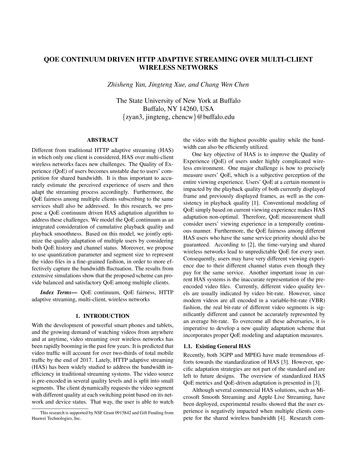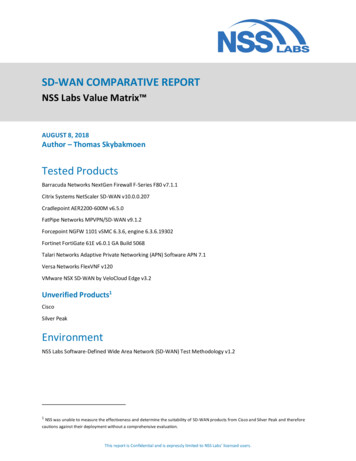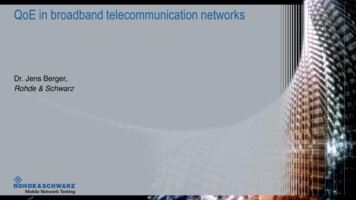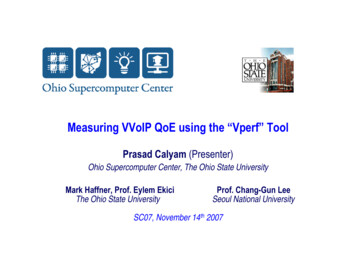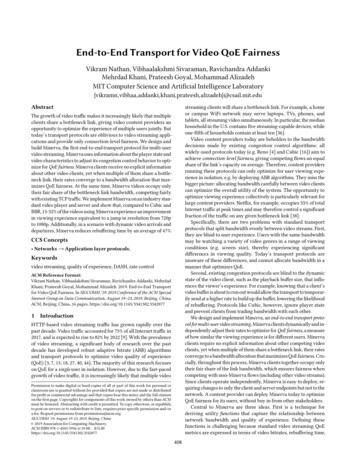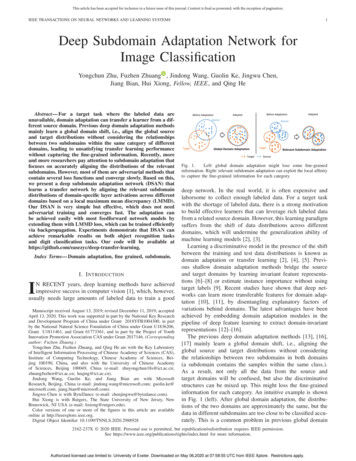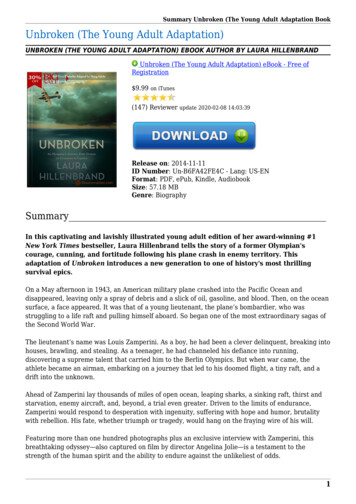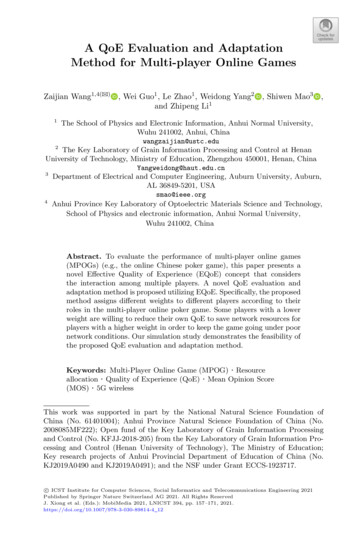
Transcription
A QoE Evaluation and AdaptationMethod for Multi-player Online GamesZaijian Wang1,4(B) , Wei Guo1 , Le Zhao1 , Weidong Yang2 , Shiwen Mao3 ,and Zhipeng Li11The School of Physics and Electronic Information, Anhui Normal University,Wuhu 241002, Anhui, Chinawangzaijian@ustc.edu2The Key Laboratory of Grain Information Processing and Control at HenanUniversity of Technology, Ministry of Education, Zhengzhou 450001, Henan, ChinaYangweidong@haut.edu.cn3Department of Electrical and Computer Engineering, Auburn University, Auburn,AL 36849-5201, USAsmao@ieee.org4Anhui Province Key Laboratory of Optoelectric Materials Science and Technology,School of Physics and electronic information, Anhui Normal University,Wuhu 241002, ChinaAbstract. To evaluate the performance of multi-player online games(MPOGs) (e.g., the online Chinese poker game), this paper presents anovel Effective Quality of Experience (EQoE) concept that considersthe interaction among multiple players. A novel QoE evaluation andadaptation method is proposed utilizing EQoE. Specifically, the proposedmethod assigns different weights to different players according to theirroles in the multi-player online poker game. Some players with a lowerweight are willing to reduce their own QoE to save network resources forplayers with a higher weight in order to keep the game going under poornetwork conditions. Our simulation study demonstrates the feasibility ofthe proposed QoE evaluation and adaptation method.Keywords: Multi-Player Online Game (MPOG) · Resourceallocation · Quality of Experience (QoE) · Mean Opinion Score(MOS) · 5G wirelessThis work was supported in part by the National Natural Science Foundation ofChina (No. 61401004); Anhui Province Natural Science Foundation of China (No.2008085MF222); Open fund of the Key Laboratory of Grain Information Processingand Control (No. KFJJ-2018-205) from the Key Laboratory of Grain Information Processing and Control (Henan University of Technology), The Ministry of Education;Key research projects of Anhui Provincial Department of Education of China (No.KJ2019A0490 and KJ2019A0491); and the NSF under Grant ECCS-1923717.c ICST Institute for Computer Sciences, Social Informatics and Telecommunications Engineering 2021 Published by Springer Nature Switzerland AG 2021. All Rights ReservedJ. Xiong et al. (Eds.): MobiMedia 2021, LNICST 394, pp. 157–171, 2021.https://doi.org/10.1007/978-3-030-89814-4 12
1581Z. Wang et al.IntroductionAs an important metric to evaluate users’ satisfaction with perceived quality,Quality of Experience (QoE) is becoming one of the key metrics in the design of5G/future networks [1], where a new era of personalized services are emergingthat emphasize service experience and users’ QoE [2]. QoE has been widelyused to describe the overall level of satisfaction of service quality from user’sperspective, and is a vital factor to evaluate the success of network traffic overfuture network systems (such as the 5G Tactile Internet).Among many emerging multimedia applications, Multi-Player Online Game(MPOG) is nowadays one of the most popular applications, which usually is oflarge-scale over wide geographical locations and keeps attracting a large numberof players. In 2010, the number of gamers has reached 20 million worldwide [3],and the PC online game market worldwide reaches 44.2 billion USD in 2020(according to statistics.com). The MPOG is a mixture that consists of a number of different subgenres, which all have various, but stringent responsivenessrequirements [3]. Different MPOGs can tolerate different performance thresholds,for example, 100 ms for First Person Shooter (FPS), 500 ms for Role PlayingGame (RPG), and 1000 ms for Real Time Strategy (RTS) [4].1.1MotivationIt has been recognized that ensuring an acceptable QoE for all players is afundamental criterion to sustain the economic success of the MPOG industry,which has been growing at a rapid pace and has attracted enormous attentionin recent years [4]. Different from individual Quality of Service (QoS) metrics,the impact of various system factors on QoE depends on the ongoing interactionamong users in the multiuser scenario [5].Going beyond conversational single-user services, MPOGs are offered in different circumstances. For example, Destiny is a blend of shooter game and massive multi-player online game. It has attracted dozens of millions of players sofar. In the game world, MPOG provides a platform for hundreds of thousandsof players to participate in a game simultaneously. By dividing the game worldinto linked mini regions that are then distributed between servers, the players ineach region are fetched by the server(s) hosting the region. Since game event handling, non-player character (NPC) control, physical hardware restrictions (suchas CPU speed and the amount of memory that is available), and persistence inthe game world management, MPOG’s servers are usually heavily loaded [6].Most existing research efforts on QoE evaluation are limited to the singleuser scenario, which rarely consider issues or provide enhancements for multiuserscenarios. Considering fast development of MPOGs that should be offered withan acceptable QoE to all the concurrent players [6], this paper is focused on thechallenging problem of QoE evaluation for MPOGs.1.2Challenges and Existing SolutionsA major challenge here is how to provide effective QoE evaluation, since QoEis influenced by both subjective and objective factors. The former includes bit
A QoE Evaluation and Adaptation Method for Multi-player Online Games159rate, jitter, delay, and so forth. The latter involves user profile, emotion, education, surroundings, etc., which are related to human subjective factors and arehard to measure and quantify. There exists many prior works on QoE evaluation to address this challenging problem. For example, the authors in [7] proposed a continuous QoE prediction engine, which was driven by three QoE-awareinputs: a QoE memory descriptor that accounts for recency, rebuffering-awareinformation, and an objective measure of the perceptual video quality. In [8],Mok, Chang, and Li aimed to construct a predictive model by incorporatingsupervised learning algorithms, in which multiclass Naı̈ve Bayes classifiers wereapplied to train a model. In a recent work [9], the authors proposed a varietyof recurrent dynamic neural networks that conduct continuous-time subjectiveQoE prediction. A study was presented in another recent work [10] on subjectiveand objective quality assessment of compressed 4K ultra-high-definition videosin an immersive viewing environment. However, such existing research effortson QoE evaluation are usually limited to the single-user scenario, which rarelyconsider the unique challenges arising in multiuser scenarios. Therefore, suchapproaches may not be effectively extended for MPOGs.Unlike QoS, QoE is a subjective assessment of media quality of users andtakes into account both technical parameters and usage context variables. Systemfactors, context, and user, along with user behavior, will all influence a user’sQoE, which in turn will influence the user’s behavior and the current state of theuser [5]. In practice, variations in service quality is unavoidable. For example, thesame user may change her QoE requirements for the same traffic condition but indifferent scenes. Therefore, it is a non-trivial challenge for network operators andservice providers, which are interested in seeking effective solutions to improvethe overall network performance and revenue. The evaluation of QoE for themultiuser scenario is still an evolving, open problem, which requires far moreworks to be done in this domain. In this paper, we aim to tackle this challengingproblem with a properly designed QoE evaluation method, which takes intoaccount the interactions among multi-players to offer uninterrupted services infuture network systems such as the 5G Tactile Internet.1.3Methodology and InnovationsWithout loss of generality, we use interactive multi-player online poker game asan example, for which QoE modeling is a vital design factor. However, owing tothe individual application types and user preferences, different players often havedifferent QoE requirements even with the same data rate in the same game; eventhe same player may have different QoE requirements in different game scenes.Therefore, a multi-level QoE model should be maintained for the game playersat runtime.Since the players play the online poker game without needing 3D graphicrendering hardware or software, game streaming often consumes very little bandwidth. For a specific player, the throughput does not need to be overly increased,because the player’s QoE cannot be further improved when the throughput issufficiently large. In the interactive multi-player online poker game, players oftenhave different levels of priority depending on their roles in the game. As illustrated in Fig. 1, some players can adjust their QoE requirements according to the
160Z. Wang et al.CustomerSalesman5GSalesmanSalesmanFig. 1. An example scenario of the online Chinese poker game.dynamic conditions to play the game with an acceptable QoE. Some players aremore willing to neglect a decrease in network resources to maintain an optimalcommunication frequency for an enjoyable game. In the example shown in Fig. 1,a few salesman are playing the game to social with their customers. Because theonline poker game will be terminated when any of the players decides to quitdue to poor QoE, the salesmen are more willing to keep playing the game bydecreasing their QoE level to provide more network resources to the customers.Considering that different players usually have different roles in the game,due to different purposes such as business, social, team building, etc., we canmake appropriate network selections accordingly in order to minimize the effectof poor network conditions for better game interactivity and an enjoyable userexperience. Because some players are willing to save or provide network resourcesfor some other players with a higher priority, by decreasing their own QoE levelin order to continue the game, it is possible to maintain the quality of the gameby relaxing some network constraints for such players.Many existing methods are focused on individual player’s perception of service quality, while ignoring the mutual influence of multiple players. We proposeto consider the special characteristics of the multi-player online poker game,which influence the player’s QoE accordingly. A new QoE evaluation methodshould reduce the impact of poor and unstable network conditions on the interactivity of the game, and maintain an enjoyable game for players even with pooror unstable network capabilities.In this particle, our main objectives and contributions are: (i) to propose an“Effective QoE” (EQoE) concept by considering the interactions among multiplayers; (ii) based on the concept of EQoE, we propose a novel QoE evaluationmethod considering the interactions among multi-players.
A QoE Evaluation and Adaptation Method for Multi-player Online Games1.4161OrganizationThe remainder of this article is organized as follows. We discuss research challenges and existing solutions in Sect. 2. Our proposed QoE evaluation methodis presented in Sect. 3. We then present a case study to demonstrate the performance of the proposed new approach in Sect. 4. Finally, we discuss open problemsand future research directions in this problem area in Sect. 5, and conclude thispaper in Sect. 6.2Research Challenges and Existing Solutions to AddressThese ChallengesCompared to the existing solutions that mainly implement QoE prediction foran individual user [9,10], some of the new challenges for QoE evaluation methodfor MPOGs include:– It is non-trivial, if not impossible, to quantify the impact of various factorsthat influence end users’ QoE.– Devices need to have high processing capabilities to meet the high CPUdemand imposed by online games.– Since hundreds of thousands of players may be served (and hence constrainedby) a single server, the players tend to flock to one area, causing the gamerelated traffic to reach an unacceptable level, and eventually causing a lowQoE for the players [6].– How to model the activities of multiple players based on effective simulationmodels [11]?– How to model the impact of various subjective and objective factors on theQoE?– How to identify new, effective Key Performance Indicators (KPIs), which cantruthfully represent the QoE?– How to model players’ preferences? The flocking of players to a hot-spot maybe triggered either by players preference for a particular region of the game,or preference of players to achieve a bonus scores to improve their profiles [6].All such factors should be considered in the QoE model.– How to employ an integrated empirical and theoretical approach towards finding the structural patterns in gaming behaviors of both humans and artificialagents [11]?Researchers have been making great effort to tackle some of the above issues.For example, in [12], the authors proposed a multiuser MAC scheduling schemefor the Wireless Virtual Reality service in a 5G MIMO-OFDM system, aiming to maximize the number of simultaneous Wireless Virtual Reality clientswhile guaranteeing their three ultra-high (3UH) QoE requirements. This schemewas composed of three novel functions, including video frame differentiationand delay-based weight calculation, spatial-frequency user selection based onmaximum aggregate delay-capacity utility (ADCU), and link adaptation with a
162Z. Wang et al.dynamic block-error-rate (BLER) target. In [13], the authors assessed the impactof several system factors, in the context of multi-party video-conferencing, on(i) user behavior, especially the interaction of participants, and (ii) the QoEconsidering user factors. Nightingale, et al. in [14] focused on providing a QoEprediction model for ultra-high-definition (UHD) video flows in emerging 5G networks. To improve QoE fairness and utilization of network resources, the authorsin [15] presented an optimization framework based on sigmoidal programmingto maximize the sigmoidal utility functions subject to network constraints. Inthis framework, the network bandwidth allocation problem for video traffic wasformulated as a network utility maximization problem, which was a nonconvexoptimization problem, and then solved with sigmoidal programming.Although some advances having been made, the existing studies have notconsidered the weight effects of players participating in the game. Most of theseQoE evaluation methods are focused on the single-user scenario, but rarely consider issues or provide enhancements for multi-player scenarios. Such approachare hard to be extended for effective QoE evaluation for MPOGs.33.1Proposed QoE Evaluation/Adaptation MethodSystem FrameworkIn the illustrative example shown in Fig. 1, there are four players participatingin the online Chinese poker game, with strong interactivity among the multiplayers. The players have different priorities depending on their roles in the game.However, a higher priority player will still be forced out of the Chinese pokergame if any of the four players quits the game (i.e., the game will be terminatedwhen the first player quits the game).Generally, the player with a higher priority has more control of running thepoker game. For example, the salesmen are more willing to play the poker gameeven if they have a low QoE (to social with the customer), while the customerwants to continue the game only if his/her QoE is satisfactory. Meanwhile, theindividual QoE should be considered since different players have different QoEs.When any of the multi-players has a poor QoE, the corresponding player willquit from this game. In this case, the poker game will be interrupted even if theothers with a higher priority are enjoying a satisfactory QoE.In order to provide more network resources to the player with a higher priority, some other players should be willing to downgrade their QoE requirementsdue to other considerations (i.e., if they wish to play the game longer). In suchcases, the players with a lower priority may still maintain a high Mean OpinionScore (MOS) value as estimated by typical QoE prediction methods.Since some low-priority players can tolerate QoE variations within a certain range, we aim to design an effective QoE evaluation method from the userdemand-centric perspective in terms of classical MOS for the multi-player scenario. We focus only on QoE evaluation, and assume that the priorities can beassigned with an existing method such as deep learning [17,18]. An agent located
A QoE Evaluation and Adaptation Method for Multi-player Online Games163at the Base Station (BS) collects information from all players, and analyzes individual QoE levels and priorities in a particular context. After executing the proposed evaluation method, the agent can make an appropriate network selectionaccording to the player’s priority and network resource requirement. The mainidea is that the proposed method may degrade some low-priority player’s QoEmomentarily, but the overall QoE the game will be maintained.3.2QoE AssessmentTo represent the satisfaction for different players, this paper adopts MOS as aqualitative measure to characterize QoE since MOS has been recognized as themost popular descriptor of perceived multiple media quality. MOS is defined inITU-T P.800, P.910 and P.920, which generally consists of five QoE levels. Fromhigh to low, the value of MOS represents “Best,” “Excellent,” “Good,” “Poor,”and “Bad” for users’ QoE, respectively. “Bad” means that the perceived qualitydrops to an unacceptable level, while “Best” indicates that the user has enjoyedthe most satisfactory experience [16].Depending on whether the player is directly involved in the assessment, existing QoE prediction methods can be categorized into subjective methods andobjective methods. The former is a direct means to obtain QoE by asking players. Therefore, it is expensive and ineffective to measure. The latter utilizesnumerical quality metrics to approximate user-perceived service quality.Since the data rate is one of the most important factors in determiningQoE [7], throughput is sometimes used to represent the QoE a player can obtainfor simplicity. In this paper, we adopt the QoE assessment method proposed inpaper [16] for individual QoE assessment. Based on the method in [16], we utilizea discrete MOS model with five limited grades to evaluate each of the players,and consider a MOS of 2 as the minimum required rating to keep the game running. Assume there are N players. The relationship between data rate and MOScan be written as a bounded logarithmic relationship function as follows [16]: 5, for θn θn4 4, for 3 a log( θbn ) 4(1)MoS(θn ) 3, for 2 a log( θbn ) 3 for n {1, 2, ., N }, 2, for 1 a log( θbn ) 2 1, for θn θn1 ,where a 3.54 /θ 1 )log(θnn1 1 3.5θb θn1 θn4 n 0 θn1 θn4 ,for n {1, 2, ., N }.(2)In this model, θn denotes the average throughput of user n, and a, b, θn1 , and θn4are model parameters, where θn1 represents the required minimum throughputand θn4 is the recommended throughput.
1643.3Z. Wang et al.The Concept of Effective QoEFor interactive multi-player online poker games, it is difficult to maintain a goodgame quality by considering only the individual QoE levels. When any of theplayers decides to quit due to an unacceptable QoE level, the online poker gamewill be stopped even if the other players have a satisfactory QoE. Therefore,we not only take account into the individual QoEs, but also consider the groupQoE. By levering the network resources among the players, the game can bemaintained at a high quality of QoE.To effectively allocate network resources among the players, a concept ofEffective QoE (EQoE) is proposed in this paper, which is different from theindividual QoE. The formulation of EQoE is given in the following.QoEe QoEm N λn (QoEn MoSL )(3)n 1,n mN λn 1,(4)n 1where QoEe represents EQoE, N is the number of players in the multi-playergame, the nth player has the corresponding QoE value QoEn obtained as in (1),λn denotes the player weight of the nth player, λm maxn {λn }, QoEm isthe QoE value of the player with weight λm , MoSL θn1 represents the lowestacceptable QoE value, which is the minimal acceptable data rate of the player.By computing (3), EQoE can be obtained for the poker game. According tothe value of EQoE, we can adjust the network resource allocation to maintain thegame at a good quality level. When QoEe QoEm , there is extra QoE resourcefor the player with the highest weight in this case, and thus we can adjust theresource allocation to decrease other players’ QoE level until QoEe QoEm oneby one according to the ascending order of player weight. Otherwise, there is noextra QoE resource for the player with the highest weight in this case.The player weights can be obtained by applying some existing methods (e.g.,see reference [17] for details) or historical records of the players. This paperfocuses on the design of a novel QoE evaluation method for multi-player onlinepoker game.3.4The QoE Evaluation/Adaptation MethodBase on the above concept and model of EQoE, we propose a novel QoE evaluation method for the online Chinese poker game, in which the network resourcesare dynamically adjusted according to the network condition and player QoE levels until no extra QoE resource remains. The procedure of the proposed methodis shown in Fig. 2. A detailed description of the scheme is given in the following.Step 1: The MoS of each player n can be calculated based on an existingQoE evaluation method for individual QoE, as proposed in [16] (e.g.,using (1)).
A QoE Evaluation and Adaptation Method for Multi-player Online Games165Fig. 2. Procedure of the proposed QoE prediction and adaptation method.Step 2: Player weight is obtained by applying the deep learning method proposed in [17] or the historical records of each player.Step 3: EQoE is obtained as in (3).Step 4: If the player with the highest weight has enough QoE resource to playthe poker game, then the agent goes to Step 11.Step 5: According to the result of Step 3, the agent decides whether to adjustnetwork resource allocation or not.Step 6: If QoEe QoEm , the agent has the capacity to adjust the networkresource allocation, by decreasing the QoEs of the players with a lowerweight to release network resource for the player with the highestweight or a higher priority. Then the agent goes to Step 8.Step 7: If QoEe QoEm , all of players will quit the current poker game. Theagent goes to Step 12.Step 8: By decreasing the QoE level of players with a lower weight untilQoEn MoSL one by one according to ascending order of playerweights, the agent allocates more network resources to the player withthe highest weight.Step 9: If QoEm is satisfactory, the agent goes to Step 11.Step 10: If QoEm is not satisfactory, the agent goes to Step 12.Step 11: Players can continual to play the game.Step 12: Players need to quit the game.Unlike the existing method [16], the proposed QoE evaluation and adaptationmethod takes into account that the players have different priorities dependingon their roles in the game, and exploits the characteristics of the online Chinesepoker game to guarantee the quality of game with the proposed EQoE concept.4Case StudyIn this section, we evaluate the effectiveness of our proposed method using theonline Chinese poker game as an example. Each game is typically played by 4
166Z. Wang et al.players, while a server can support a large number of games (and thus players)simultaneously. In the simulations of the typical online Chinese poker game,we assume 128 kbps as the required minimal throughput and 512 kbps as therecommended throughput as used for Skype. Therefore we have θn1 128 kbpsand θn4 512 kbps.In order to evaluate the effectiveness of our proposed method, we use the traditional method in [7] as a baseline scheme. The simulations are executed usingthe Matlab platform, and each result is the average of 50 runs. We comparedthe utilization of throughput in the proposed method with that of traditionalQoE prediction method. It is assumed that the user’s QoE and weight follow theGaussian distribution in the range of [128 kbps, 512 kbps]. During the Chinesepoker game, there are also some other real-time traffic with a higher priority(such as banking by phone, e-health services) transmitted, which also followsthe Gaussian distribution in the range of [0, 50 Mbps].When there is background traffic with higher priority, the available networkthroughput for the game players will be reduced. The traffic with higher prioritywill be protected by decreasing the game player’s QoE levels temporarily with theproposed method. However, the traditional method will interrupt some playersto provide network resources for the high-priority traffic. Therefore, we can seethat the proposed method has obviously achieved a better performance than thetraditional method in terms of throughput utilization and the number of playerssupported, as shown in Fig. 3, Fig. 4, Fig. 5, and Fig. 6.Specifically, Fig. 3 shows that the proposed method has achieved higherthroughput utilization than the traditional method under the same influencefrom the higher priority background traffic. This is because the traditionalmethod does not take into account that all the 4 players of an online Chinese poker game will be interrupted when any of the players is interrupted dueto insufficient throughput. Unlike the traditional method, the 4 players of theonline Chinese poker game are assigned with different weights in the proposedscheme. Some players with a lower weight are willing to reduce their QoE levelto save network resources for players with higher weights, in order to continueplaying the game.Figure 4 shows that the proposed method can accommodate more playersthan the traditional method. During the period of time when the high-prioritybackground traffic is heavy, the number of players still remains high with theproposed method. However, the number of players is much smaller with thetraditional method under the same background traffic pattern. This is also dueto the specific design of the proposed scheme that introduce different prioritiesto the game players and exploit the priorities in network resource allocation.Figure 5 presents the average throughputs of player with different weightswith the proposed method. It can be seen that the throughputs are very different, since the proposed method maintains players’ QoE according to theirweights. When the background traffic with a higher priority is heavy, the average throughput of player with higher weight keeps stable. However, the averagethroughput of the player with a lower weight is much lower than that of the
A QoE Evaluation and Adaptation Method for Multi-player Online Games1670.82throughput utilization (%)Proposed methodTraditional method0.80.780.760.740.7201020304050Time (min)60708090Fig. 3. Comparison of two methods in terms of throughput utilization.320Number of Players300Traditional methodProposed method28026024022020001020304050Time (min)60708090Fig. 4. Comparison of two methods in terms of the number of concurrent playerssupported.player with a higher weight, and it changes with the requirements of the background traffic with higher priority. The average throughput of the player witha lower weight is decreased to better accommodate the higher priority trafficin order to keep the game going under poor network conditions. In Fig. 6, wecan see that the average throughput of the player with a higher weight remainshigh, even though the high-priority background traffic is continuously increased,while the average throughput of the player with a lower weight decreases withthe increased background traffic.
168Z. Wang et al.Average Player Throughput (Kbps)340320300The player with lower weightThe player with higher weight28026024022020018001020304050Time (min)60708090Fig. 5. Comparison of the average throughput of players with different weights overtime.Average Player Throughput (Kbps)340320300280260240220200180160140The player with lower weightThe player with higher weight12005101520253035404550Higher Priority Traffic Throughput (Mbps)Fig. 6. Comparison of the average throughput of players wit different weights underincreased high-priority background traffic.Unlike the existing works that consider only individual QoE, our proposedmethod takes into account the fact that different players have different roles andweights in the multi-player online poker game, where some players with a lowerweight are willing to reduce their QoEs to save network resources for playerswith a higher weight to keep the game going under poor network conditions.
A QoE Evaluation and Adaptation Method for Multi-player Online Games5169Future Directions and Open ProblemsQoE-related research and applications are still in the infancy stage, and onlylimited work has been done in the field. QoE-related technologies are lacking ona systemic and in-depth research. There are many obstacles in the development ofQoE-related applications. In 5G and beyond network systems, many new onlinemultimedia services and traffic types are emerging. Some potential challenges inthe fields of QoE research are provided as follows.– Subjective factors: QoE is influenced by a lot of subjective factors, such asuser’s mood, specific preference, attention, expectations, service ease of use,context, etc. Until today, there are also a lot of unknown factors. Some factorsmentioned above still need further study. It is difficult to find kernel factorsto describe QoE since a lot of subjective factors are highly sophisticated.Meanwhile, it is a challenge to effectively quantize and model these factors.– Nonlinear fusion: QoE is affected by a variety of factors from differentfields. The knowledge of factors is generally obtained from heter
an example, for which QoE modeling is a vital design factor. However, owing to the individual application types and user preferences, different players often have different QoE requirements even with the same data rate in the same game; even the same player may have different QoE requirements in different game scenes.
